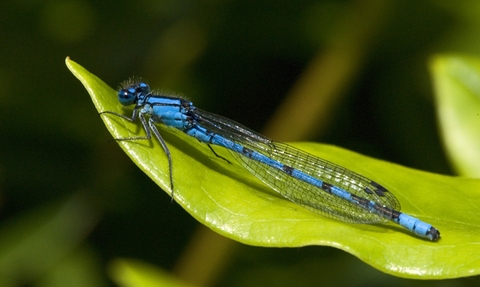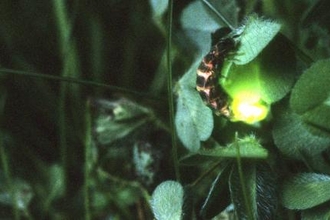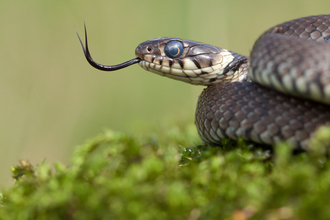
©Les Binns
Where to see dragonflies and damselflies
Dragonflies and damselflies
No summer outing would be complete without hearing the tell-tale sound of a patrolling dragonfly as it hunts over a nearby pond. Their aerial manouvres rival the fastest military aircraft as they duck and turn in pursuit of prey, or narrowly avoid the clutches of hungry hobbies. These adaptable insects lord over wetlands, moorland and even woodland glades, feeding on flies, midges and even each other. If you thought butterflies were the only insects worth a second glance, these multi-coloured, iridescent predators demand appreciation too.
Darting, slowing, hovering and then onwards again; the dragonfly reveals both the beauty of its sunshot wings and its complete mastery of the air
Find dragonflies and damselflies near you
Do a little research in advance and find out some of the best Wildlife Trust reserves to see dragonflies and damselflies.
North
Cheshire Wildlife Trust
Black Lake - A natural hidden gem, Black Lake sits in the heart of Delamere Forest Park. It is home to a vast range of dragon and damselflies, which can be enjoyed at close quarters from the shores of this remnant ‘schwingmoor’ bog pool. Highlights include brown hawker, four-spotted chaser and ruddy darter.
Danes Moss - A mosaic of bog pools and woodland, dragonfly numbers at Danes Moss can be astounding, with many species often flying to investigate visitors and land on brightly-coloured clothing. Our smallest dragonfly the black darter can be seen here, and the Trust is undertaking works to improve habitats for these aerial acrobats.
Cumbria Wildlife Trust
Foulshaw Moss - An ancient raised mire with 11 species, including emerald and blue-tailed damselfly, black darter and emperor dragonfly. In summer common lizards, adder and slow worm may also be encountered. The white-faced darter, found on only one other site in Cumbria, is being reintroduced here.
Barkbooth Lot - Damsel and dragonflies are numerous around the tarns - more than 10 species have been recorded. The downy emerald dragonfly breeds here, as do the emperor, common darter and four-spotted chaser. Damselflies are also abundant with common blue, azure and large red the most likely to be encountered. The beautiful demoiselle can also be seen.
Lancashire Wildlife Trust
Summerseat Nature Reserve - Woodland with a stand of common reed, the two ponds on the site provide a fascinating habitat for dragonflies and damselflies such as the broadbodied chaser, the large red damsel, the southern hawker, the common hawker and the emerald damselfly. Amphibians are also abundant, with both smooth and palmate newts present.
Boilton Wood - Wildlife lies around every corner of Boilton, Nab, Red Scar and Tunbrook Woods.
Northumberland Wildlife Trust
Falstone Moss - Upland bog with a boardwalk allowing you to see the wildlife in and around the pools. Rare plants grow amoung the sphagnum mosses, and the central pool has golden-ringed dragonfly, common hawker, black and common darter, and large red, azure and emerald damselfly.
Tees Valley Wildlife Trust
Coatham Marsh - This is Tees Valley Wildlife Trust’s premier reserve for dragonflies and damselflies. Take a stroll around the ponds and pools in the post industrial landscapes and you may see glimpses of the these insects in amongst the extensive reed beds. A good site to see common darter, common blue and large red damselflies as well as water vole, orchids and many wetland birds.
Yorkshire Wildlife Trust
Potteric Carr - Yorkshire WT’s largest reserve, the main habitats include open water, reedbed, woodland, marsh, and small meadows, all of which create a rich diversity of wildlife. A total of 21 species of dragon and damselfly have been recorded, including azure damselfly, brown hawker and common darter.
North Cave Wetlands - North Cave Wetlands is a true example of a 21st Century nature reserve, developed in the footprint of a large sand and gravel quarry. From spring avocets and common terns, summer dragonflies, to wintering flocks of wildfowl, a day spent here at any time of year will reward.
Letchmire Pastures - When the sun begins to shine and the days get longer delicate bee orchids bloom in this wild, reclaimed former colliery site, where meadows and a young woodland thrive and various dragonfly species dominate the wetland.
Midlands
Derbyshire Wildlife Trust
Carr Vale Flash - With 17 species, this former coalfield is one of the best dragonfly sites in Derbyshire. The big four are emperor dragonfly, four-spotted chaser, black-tailed skimmer and ruddy darter, all threatened in the county.
Leicestershire Wildlife Trust
Kelham Bridge - Once an area used for the disposal of sewage waste, this reserve is still in its infancy. Even so, a great variety of wildlife has already been recorded on the site, including 16 dragonfly species. Look for migrant and southern hawker, black-tailed skimmer, ruddy darter, banded demoiselle and emerald damselfly among others.
Lincolnshire Wildlife Trust
Whisby Nature Park - The variety of lakes, ponds and running water make this former site of sand and gravel workings rich in dragon and damselflies. In total 23 species have been recorded. Highlights are the red-eyed damselfly, hairy dragonfly, black-tailed skimmer and ruddy darter which are all regularly seen.
Nottinghamshire Wildlife Trust
Attenborough - In the spring and summer the reserve is a hive of insect activity. Many dragonflies and damselflies hunt and patrol the water’s edge, including banded demoiselle, emerald and small red-eyed damselfly, emperor dragonfly and brown, migrant and southern hawkers.
Shropshire Wildlife Trust
Cramer Gutter and Catherton Common - Between them these two adjoining reserves support a variety of dragon and damselfly species, including the golden-ringed dragonfly and one of the few populations of keeled skimmers in the West Midlands. Carnivorous plants and other bog species also thrive on the common.
Staffordshire Wildlife Trust
Bateswood - A 61 acre grassland site with several pools and fish-free scrapes; perfect for dragonfly larvae. The water is shallow and warms quickly and there is plenty of aquatic vegetation to allow the dragonflies to emerge. Species include common and black darter, four-spotted chaser and emperor dragonflies, as well as common blue, azure, emerald and blue-tailed damselflies.
Warwickshire Wildlife Trust
Leam Valley - A fantastic nature reserve on the edge of Leamington Spa.
Swift Valley - This reserve on the edge of Rugby adjoins the River Swift and includes pools, an unused canal and grassland with pronounced ridge and furrow characteristics. Species of note include the hairy dragonfly, small red damselfly, southern hawker amongst others.
Welches Meadow - This reserve is a flood meadow on the south bank of the River Leam, which is great for spotting butterflies and dragonflies.
South
Avon Wildlife Trust
Weston Moor - Part of the North Somerset Levels, Weston Moor is a wonderful site for dragon and damselflies - the hairy dragonfly has been spotted here and recent sightings include azure, blue tailed and emerald damselflies. Wildlife film-maker Steve Nicholls says he gets just as big a kick from seeing four spotted chasers here as anything in his global wanderings!
Berks, Bucks and Oxon Wildlife Trust
Decoy Heath - This restored gravel pit is the best place in Berkshire for dragonflies and damselflies, such as the downy emerald dragonfly and rare small red damselfly. Other notable species recorded here include brilliant emerald dragonfly, yellow-winged darter, beautiful demoiselle and emerald damselfly. The reserve is also renowned for its mosses and lichens.
Cornwall Wildlife Trust
Ventongimps Moor - This nature reserve is an exceptionally rich mosaic of wet and dry heath, with areas of bog, ponds and woodland and is one of the best sites for dragon and damselflies in Cornwall. The reserve supports 13 species, including the nationally rare scarce blue-tailed damselfly.
Devon Wildlife Trust
Bystock Pools - A wet valley bottom adjoining a reservoir, it contains wet heath communities dominated by purple moor grass together with species such as cross leaved heath. The pools support important populations of dragonflies and damselflies, with emperor, downy emerald and goldenringed dragonflies and small red damselfly.
Dorset Wildlife Trust
Upton Heath - Rare mire habitat with 25 recorded species, at least 14 of them breeding. Look out for downy emerald and heathland specialists such as small red damselfly and black darter. The reserve also supports two carnivorous plants and all six native UK reptile species are found on the dry heath.
Gloucestershire Wildlife Trust
Woorgreens Lake and Marsh - The best dragonfly spot in the Forest of Dean with 17 breeding species, including a large population of the scarce blue-tailed damselfly. Developed from open cast iron workings, the site now has a great selection of marsh, lake and heath habitats.
Hampshire & Isle of Wight Wildlife Trust
Pamber Forest - Dragonflies can be found in the woodland streams and ponds during the breeding season, and hunting for prey along the woodland rides. Over 20 species have been recorded including club-tailed dragonfly, which was a first for Hampshire, and the white-legged damselfly. A great site for seeing beautiful demoiselle damselfly and golden ringed dragonfly too.
Kent Wildlife Trust
Hothfield Heathland - Not only does this reserve contain the last four valley bogs in Kent, this reserve also allows observation of one of the last ancient heathlands in England. It is noted for dragonflies such as the keeled skimmer and is also a good site for common lizard and grass snake.
Somerset Wildlife Trust
Westhay Moor - You won’t get far on a summer’s stroll along the reed-lined paths before a stylish southern hawker whizzes past or an imperious emperor dragonfly cruises by in search of prey. However, don’t get too distracted by the biggest and showiest; with 20 species recorded here, there are plenty of others to enjoy, including black-tailed skimmers, ruddy darters and more.
Surrey Wildlife Trust
Thundry Meadows - Picturesque wet meadow complex beside the River Wey with alder carr, farmland and ditches. It hosts several rare plants and sedges and is one of the few remaining wet meadow complexes left in the county. There are many rare plants and butterflies and at least 24 species of dragonfly and damselfly.
Sussex Wildlife Trust
Amberley Wildbrooks - Consisting of grazing marsh and ditches in a former flood plain, the reserve supports a fantastic array of wetland plants and insects, some of which are nationally rare. Hundreds of dragonflies and damselflies hawk relentlessly up and down the ditches, including the scarce chaser, downy emerald and hairy dragonfly.
Wiltshire Wildlife Trust
Smallbrook Meadows - The reserve is made up of disused water meadows, ditches, woodland and a pond. Species include southern hawker, migrant hawker, ruddy darter, emperor and common darter dragonflies, common blue and blue-tailed damselflies and the banded demoiselle.
East
Beds, Cambs and Northants
Felmersham Gravel Pits - This rich mosaic of woodland, grassland and idyllic lakes is one of the best places for dragonflies in Bedfordshire. At least 18 species breed here and more visit via the nearby river Great Ouse. Species to look for in the summer include hairy dragonfly, white-legged, red-eyed and azure damselflies.
Herts and Middlesex Wildlife Trust
Amwell nature reserve - Nineteen species of dragon and damselfly have been recorded here, making the reserve Hertfordshire’s best site for dragonflies. These include hairy dragonfly, red-eyed damselfly, southern and brown hawker, ruddy and common darter. A dragonfly trail with boardwalk, allows close up views of them hunting over open water.
Norfolk Wildlife Trust
Upton Broads and Marshes - In the words of local naturalist Ted Ellis, ‘a breathing space for the cure of souls’. It’s awash with dragonfly and damselfly species during the spring and summer, including the unusual variable damselfly, blue damselfly, hairy dragonfly and the unique Norfolk hawker.
Suffolk Wildlife Trust
Lackford Lakes - This Site of Special Scientific Interest is a system of former gravel pits lying beside the river Lark. A great site for dragonflies and damselflies, which can be seen hovering above the open water. The broad-bodied chaser dragonfly is highly territorial and can possessively hog a boundary marker like a stone or reed for days on end.
Wales
Gwent Wildlife Trust
Magor Marsh - This wetland reserve is criss-crossed by drainage ditches (locally known as reens) where its easy to see dragonflies and damselflies on hot summer days as you walk around the circular trail . About 15 species have been recorded including the hairy dragonfly, the UKs smallest hawker, and the ruddy darter.
Montgomeryshire Wildlife Trust
Cors Dyfi Reserve - As well as hosting the nationally important Dyfi Osprey Project, the reserve teems with dragonflies during the summer. Look for golden-ringed, hairy and emperor dragonflies, broad-bodied chaser, black darter and blue-tailed damselfly, among others. Free entry to MWT members.
North Wales Wildlife Trust
Cors Goch - A beautiful mosaic of wetland, reedbed and scattered ponds with up to 15 species of dragonfly and damselfly mingling with butterflies that drift down from the heathland and grassland areas. Species include variable and scarce blue-tailed damselfly, and emperor and golden-ringed dragonfly.
Radnorshire Wildlife Trust
Pentrosfa Mire - A flooded valley reserve and Site of Special Scientific Interest, primarily because of its high botanical interest. The reserve supports a variety of dragonfly species including azure and large red damselfles, common, brown and southern hawker, keeled skimmer, broad-bodied chaser and common darter.
The Wildlife Trust for South and West Wales
Parc Slip Nature Park - A restored opencast site consisting of grassland, woodland, wetlands, including lakes with bird hides. Twenty species of dragonfly have been recorded here, including the emperor, four spot chaser, and the scarce blue-tailed damselfly.
Scotland
Scottish Wildlife Trust
Glen Moss Wildlife Reserve - Marshland with woodland, heathland and open water, all of which is accessible by a path that winds throughout the reserve. There are nine breeding species of dragonfly and damselfly here, and the golden-ringed dragonfly is an occasional visitor. Look out for pearl-bordered fritillary butterflies too.
Northern Ireland
Ulster Wildlife Trust
Balloo Wetland - Ulster WT’s newest nature reserve, Balloo is in fact made up to two sites: wetland and woodland. The wetland site is home to a variety of dragonflies and damselflies which can be viewed from the walkways around its two ponds. Birds such as kingfisher may also be spotted from the hide.
Bog Meadows - An oasis for wildlife and people in the city, comprising a mosaic of reedbeds, meadows, ponds, woodland, streams and hedgerows. Species to look out for include common darter and hawker species, as well as common blue, blue-tailed, large red and azure damselflies.
Islands
Alderney Wildlife Trust
Longis Nature Reserve - A sweeping 105ha coastal reserve including high energy intertidal wetlands, species rich coastal grassland, freshwater wetlands and scrub.
What to look for
There are 17 species of damselfly and 23 species of dragonfly resident in the UK, with the occasional visitor from continental Europe. Found in almost every habitat, these fearsome aerial predators bring a splash of colour just as wildflowers and butterflies are winding down. And for the birdwatchers that hang up their binoculars before the big migration events of autumn, they provide another burst of wildlife watching activity to rival any bird flocks.
Know the difference! As a general rule, the damselfly is slimmer, and rests with wings folded, while the stockier dragonfly keeps its wings spread outwards. The earliest damselflies are on the wing by early May, while the last common darter of the year might still be flying on a warm October day, with the highest species diversity found during July and August. Like most insects, dragonflies are at their most active in warm sunny conditions, so pick your day wisely. Binoculars will come in handy, as most will fly off if you get too close. And of course, take care at the water’s edge.
If you can't get there
Don’t worry if you can’t make it to one of these amazing reserves, there are very few places where you don’t stand a chance of finding a dragonfly. Several species travel a long way away from water, to feed in gardens, fields and woodland edges. One of the greatest wanderers is the migrant hawker, which you can often find hunting along sheltered hedgerows in August and September.
More wildlife experiences
From seeing colourful wildflowers to spotting magnificent birds of prey, we can help you get closer to wildlife across the UK.




